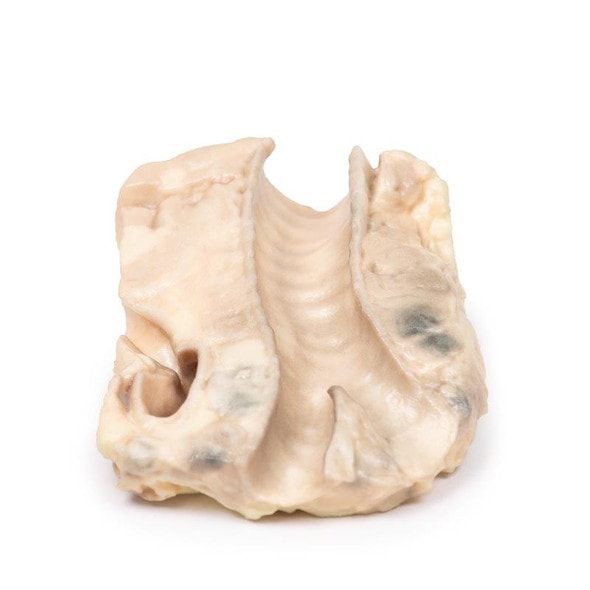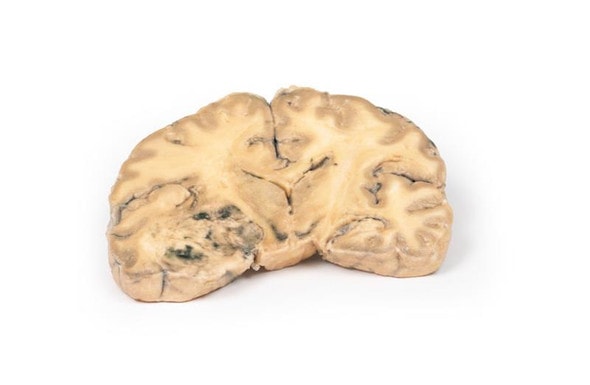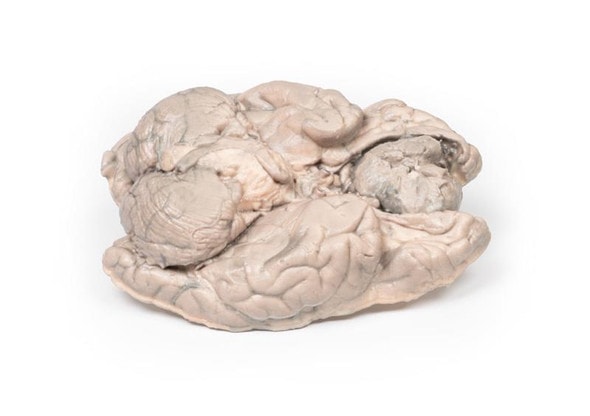Description
Developed from real patient case study specimens, the 3D printed anatomy model pathology series introduces an unmatched level of realism in human anatomy models. Each 3D printed anatomy model is a high-fidelity replica of a human cadaveric specimen, focusing on the key morbidity presentations that led to the deceasement of the patient. With advances in 3D printing materials and techniques, these stories can come to life in an ethical, consistently reproduceable, and easy to handle format. Ideal for the most advanced anatomical and pathological study, and backed by authentic case study details, students, instructors, and experts alike will discover a new level of anatomical study with the 3D printed anatomy model pathology series.
Clinical History
A 68-year old woman presented with a small hard lump in the thyroid. During the following six weeks, there was progressive rapid enlargement of the mass leading to laryngeal stridor and oesophageal obstruction, which were the terminal features. No lymph nodes were enlarged and there was no splenomegaly.
Pathology
The larynx, thyroid, upper trachea and oesophagus are included in the specimen. The enlarged left lobe and to a lesser degree, the right lobe of the thyroid, are replaced by homogeneous pale tumor tissue. Stretched over the lateral margin of the left lobe is the common carotid artery. Note on the internal aspect how the larynx is compressed and the oesophagus virtually disappears into the bulk of the tumor. The histological appearance of the tumor was consistent with lymphoblastic lymphoma of the thyroid. The rarity of this tumor makes it necessary to exclude the diagnosis of anaplastic carcinoma of the thyroid, and secondary spread from lymphoma elsewhere.
Further Information
Primary lymphoma of the thyroid is rare but should always be considered as a differential diagnosis of any thyroid mass or nodule. Primary thyroid lymphomas are rare, and are usually of the non-Hodgkin type. Lymphoblastic lymphoma is an aggressive form of non-Hodgkin's lymphoma (NHL), usually seen in children. Currently, the only known risk factor for developing primary thyroid lymphoma is chronic autoimmune (Hashimoto's) thyroiditis, with a 50% occurrence rate.
Thyroid lymphoma should be considered in any individual presenting with a rapidly enlarging goiter, as over 90% of individuals with this disease present this way. As the goiter enlarges, there can be compression of nearby structures such as the trachea, oesophagus and neck vessels (the common carotid in this case). The resulting symptoms include stridor or hoarseness, dysphagia and neck pain. Other systemic symptoms of lymphoma include so-called B-symptoms, i.e. night sweats, fevers and loss of weight.
Diagnosis can be achieved by an ultrasound scan followed by fine needle aspiration or excisional biopsy. As thyroid lymphomas cannot be excluded from Hashimoto's or other carcinoma, cytology and immunohistochemical stain of the biopsied tissue is required to confirm the diagnosis.
Advantages of 3D Printed Anatomical Models
- 3D printed anatomical models are the most anatomically accurate examples of human anatomy because they are based on real human specimens.
- Avoid the ethical complications and complex handling, storage, and documentation requirements with 3D printed models when compared to human cadaveric specimens.
- 3D printed anatomy models are far less expensive than real human cadaveric specimens.
- Reproducibility and consistency allow for standardization of education and faster availability of models when you need them.
- Customization options are available for specific applications or educational needs. Enlargement, highlighting of specific anatomical structures, cutaway views, and more are just some of the customizations available.
Disadvantages of Human Cadavers
- Access to cadavers can be problematic and ethical complications are hard to avoid. Many countries cannot access cadavers for cultural and religious reasons.
- Human cadavers are costly to procure and require expensive storage facilities and dedicated staff to maintain them. Maintenance of the facility alone is costly.
- The cost to develop a cadaver lab or plastination technique is extremely high. Those funds could purchase hundreds of easy to handle, realistic 3D printed anatomical replicas.
- Wet specimens cannot be used in uncertified labs. Certification is expensive and time-consuming.
- Exposure to preservation fluids and chemicals is known to cause long-term health problems for lab workers and students. 3D printed anatomical replicas are safe to handle without any special equipment.
- Lack of reuse and reproducibility. If a dissection mistake is made, a new specimen has to be used and students have to start all over again.
Disadvantages of Plastinated Specimens
- Like real human cadaveric specimens, plastinated models are extremely expensive.
- Plastinated specimens still require real human samples and pose the same ethical issues as real human cadavers.
- The plastination process is extensive and takes months or longer to complete. 3D printed human anatomical models are available in a fraction of the time.
- Plastinated models, like human cadavers, are one of a kind and can only showcase one presentation of human anatomy.
Advanced 3D Printing Techniques for Superior Results
- Vibrant color offering with 10 million colors
- UV-curable inkjet printing
- High quality 3D printing that can create products that are delicate, extremely precise, and incredibly realistic
- To improve durability of fragile, thin, and delicate arteries, veins or vessels, a clear support material is printed in key areas. This makes the models robust so they can be handled by students easily.




















